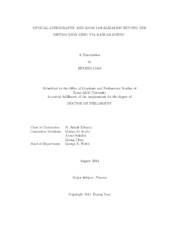| dc.description.abstract | The resolution of traditional optical microscope and optical lithography is limited by about half wavelength of the light source, which is well known as the diffraction limit or Abbe limit. The resolution limit is due to the missing of high spatial frequency components in the far-field. One way to achieve high resolution is to move the detector into the near-field region where the evanescent wave can be collected. However, these methods are surface-bound and usually very slow which have limited applications. It has long been an interesting and important question about how to overcome the diffraction limit in the far-field.
For optical lithography, a number of methods have been proposed to overcome the diffraction limit such as multi-photon scanning, quantum entanglement, quantum inspired process (e.g., dopperlon), and quantum dark state. However, these methods either require multi-photon absorber, quantum entanglement, or multi-energy levels, which restrict them from extending to higher resolution in practice. In this thesis, we showed that sub-diffraction-limited resolution can be generated by the coherent Rabi gradient. This method does not require multi-photon absorber or quantum entanglement but just quantum coherence of the medium. Extension from lower resolution to higher resolution is very straightforward where we just need to increase the pulse intensity or pulse duration. We also proposed two atom lithography experiments based on the Rabi gradient. The first one uses Rubidium Rydberg atom and microwave where we showed that sub-micrometer line spacing is possible. The second one uses Chromium atom and optical field where we showed that sub-10nm line spacing is possible while the wavelength of the light is about 400nm.
For optical imaging, a number of methods have also been proposed to achieve super-resolution such as multi-photon microscope, stimulated-emission-depletion, structured illumination microscopy, centroid-based techniques and metamaterial-based lens. Here, we will show a new method to achieve resolution beyond the diffraction limit which we called it resonance fluorescence microscopy. Resonance fluorescence has been proposed to localize a single atom with resolution beyond the diffraction limit. The separation between two atoms can also be extracted from the resonance
fluorescence spectrum. To develop it as microscopy, we need to evaluate the resonance fluorescence spectrum of multiple-atom system. We analytically solved the general feature of the spectrum when the Rabi frequency is much larger than the dipole-dipole interaction and showed how to extract the spatial information of the atoms with resolution far beyond the diffraction limit. This method is entirely based on far-field techniques and it does not require point-by-point scanning. | en |


